Imagine a living space that combines Japanese minimalism with Scandinavian warmth. Welcome to Japandi, a design trend that’s changing home décor. But what is Japandi, and how can you bring it into your living room?
In this guide, we’ll explore Japandi’s design philosophy. We’ll look at its core principles, color palettes, and key elements. Plus, we’ll share 15 cozy Japandi living room ideas to make your space a tranquil and stylish oasis.
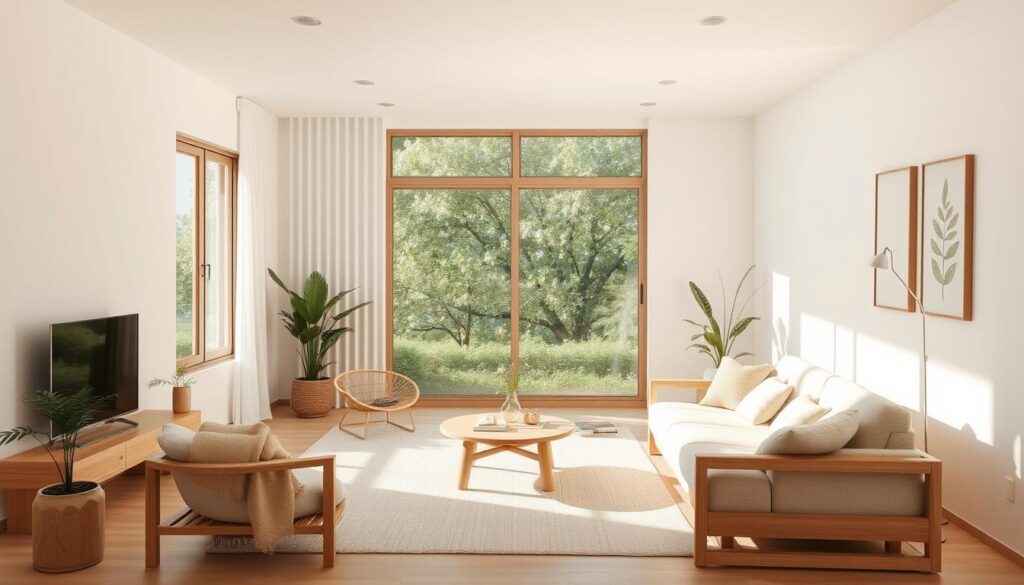
Are you ready to create a living room that blends Japanese and Scandinavian design? Let’s start our Japandi journey and discover how to make a space that’s both beautiful and practical.
Key Takeaways
- Japandi design is a mix of Japanese and Scandinavian styles, focusing on minimalism and natural elements.
- Japandi living rooms are simple, functional, and use natural materials like wood and stone.
- Using Japandi design principles can make your living space cozy, serene, and stylish.
- Japandi style values balance, harmony, and a clean environment.
- Mastering Japandi design can turn your living room into a calming oasis that shows your personal style.
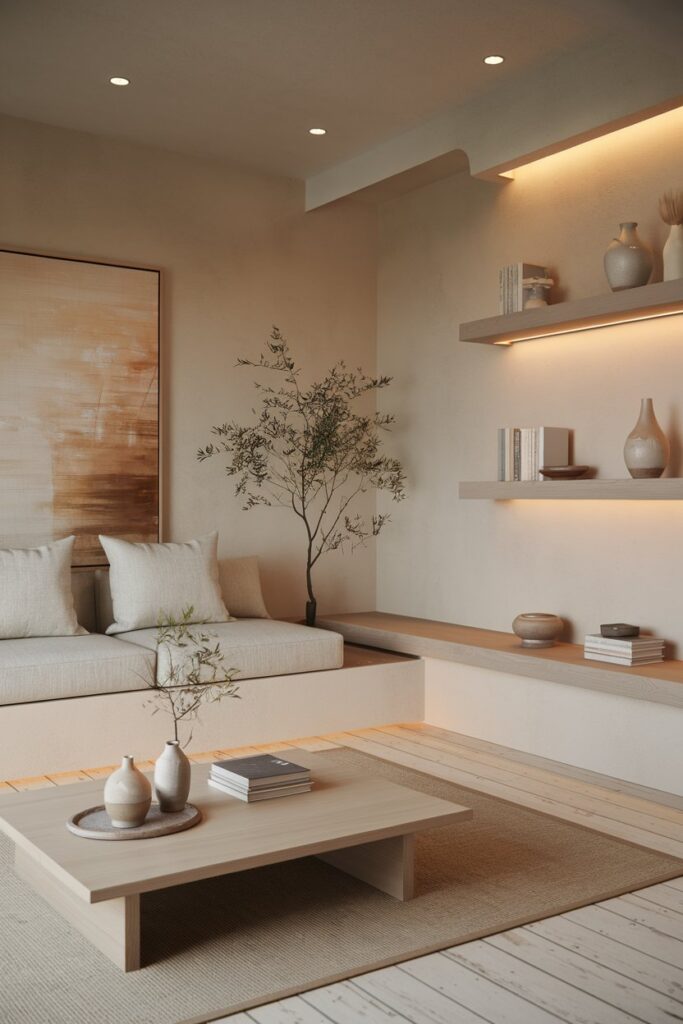
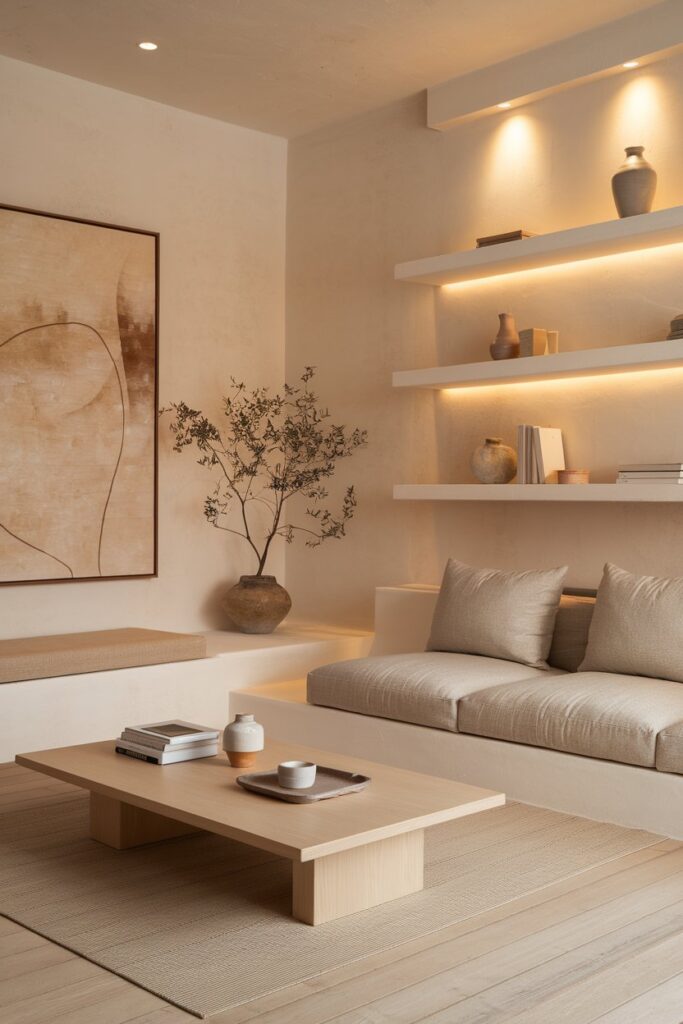
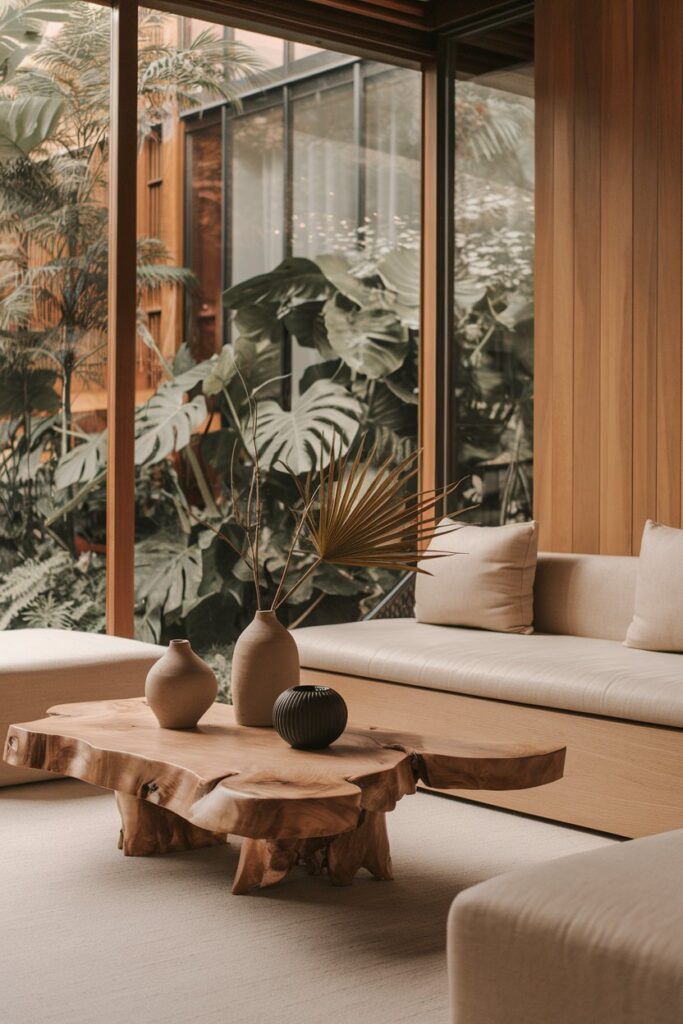
Understanding the Japandi Design Philosophy
Japandi is a design style that combines Japanese and Scandinavian aesthetics. It’s perfect for those who want a calm, minimalist home. It’s based on wabi-sabi and hygge, focusing on the beauty of natural materials and simplicity.
The Fusion of Japanese and Scandinavian Aesthetics
Japandi design mixes Japanese simplicity with Scandinavian coziness. This blend creates a peaceful space. It uses clean lines, neutral colors, and natural textures to promote calm and well-being.
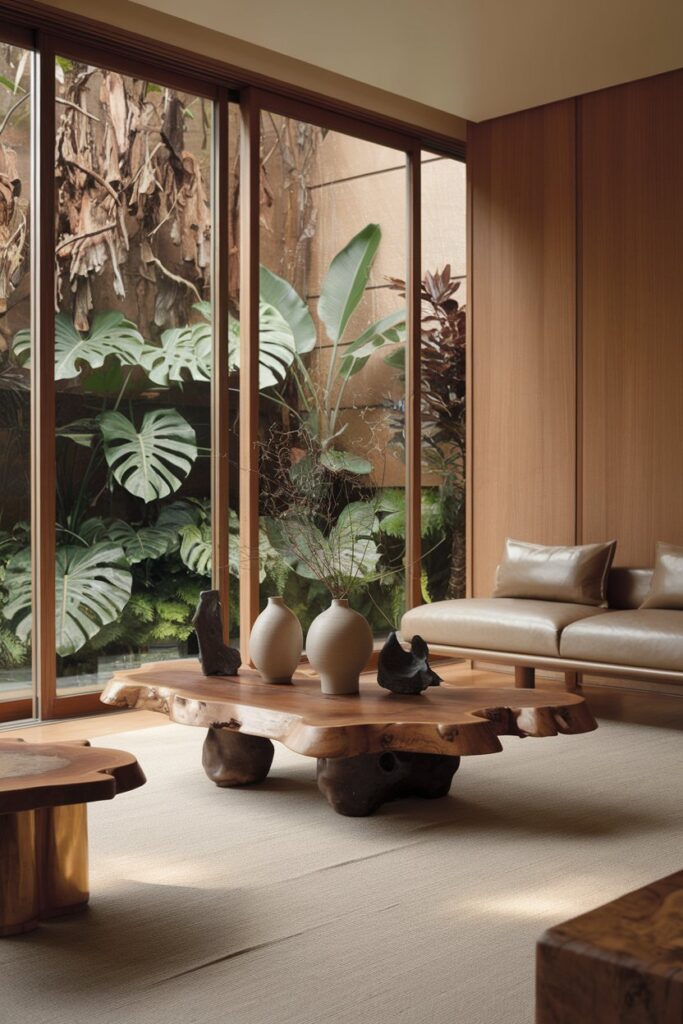

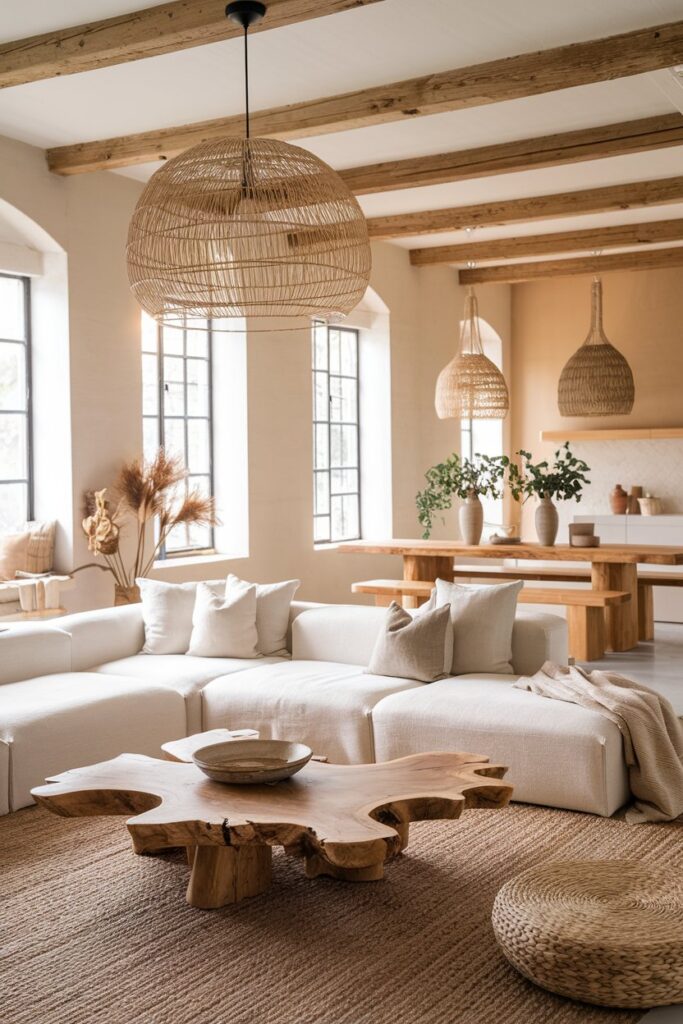
Core Principles of Japandi Style
- Embrace wabi-sabi, finding beauty in imperfection and aging.
- Use the Danish concept of hygge to create a cozy atmosphere.
- Choose natural materials like wood and stone to connect with nature.
- Follow a minimalist approach for a clean, uncluttered space.
Why Choose Japandi for Your Living Space
Japandi design brings many benefits to your home. It promotes mindfulness and relaxation. The use of natural materials and clean lines makes your living room feel spacious and welcoming.
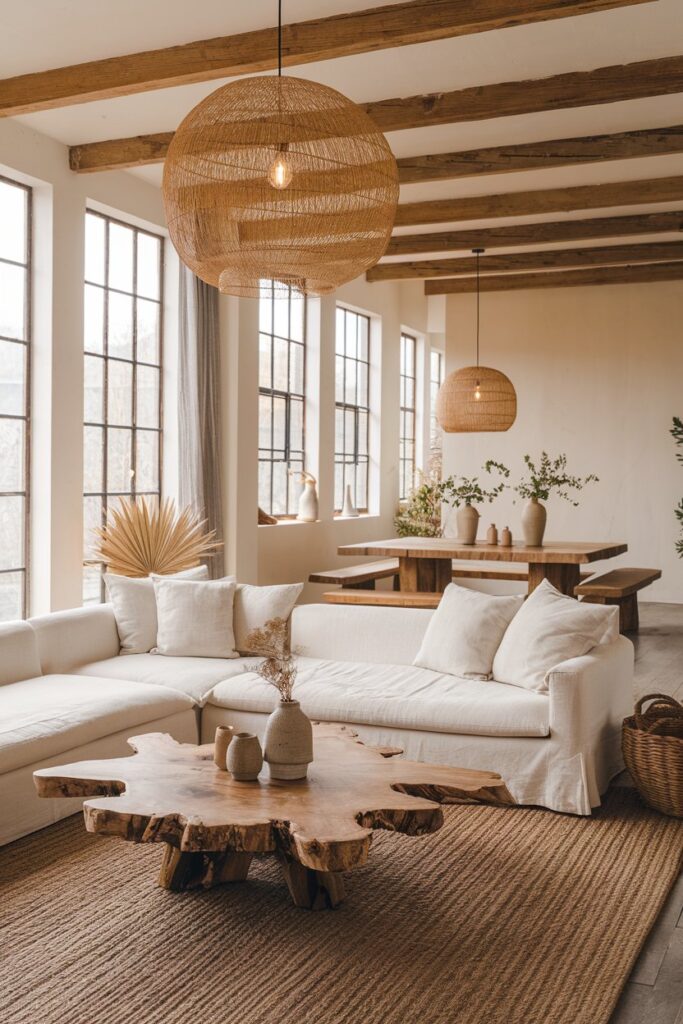
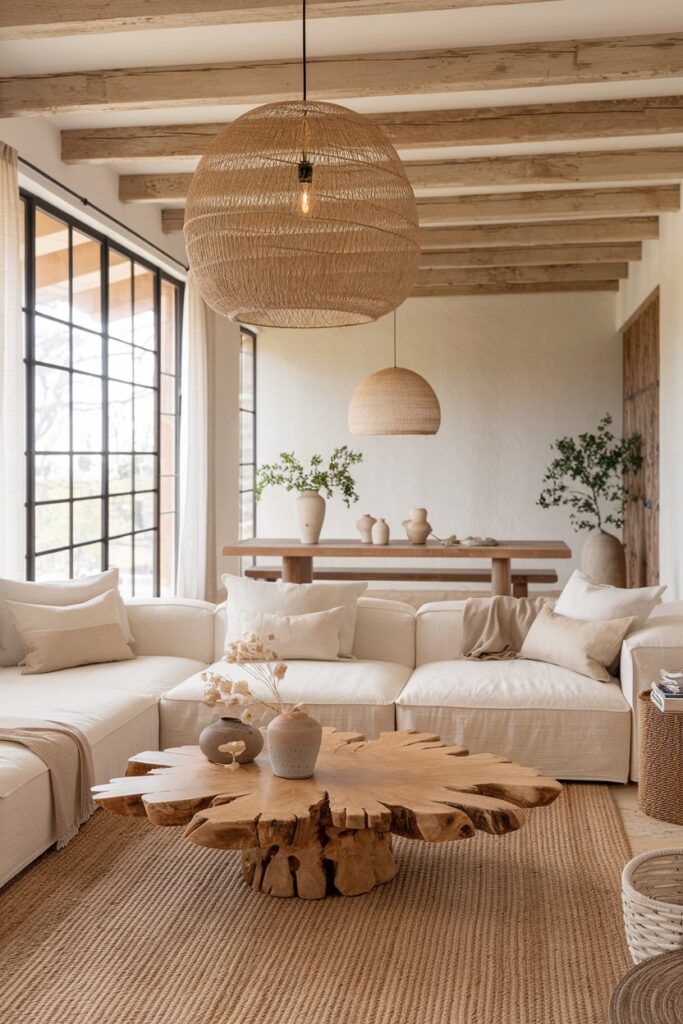

Essential Elements of a Japandi Color Palette
The heart of Japandi design is its color palette. It combines neutral colors, earthy tones, and muted hues. This mix creates a peaceful and welcoming space. To get the Japandi look in your living room, focus on this color harmony.
Begin with a base of neutral grays, soft whites, and natural wood tones. These colors set a calm background. They let other elements stand out.
Add earthy accents like sage greens, warm ochres, and deep terracotta. These muted tones bring warmth and depth. They make the space feel cozy and inviting.
| Neutral Colors | Earthy Tones | Muted Hues |
|---|---|---|
| Gray | Sage Green | Terracotta |
| White | Ochre | Olive |
| Natural Wood | Beige | Charcoal |
Balance neutral colors, earthy tones, and muted hues for a Japandi living room. It will be peaceful and stylish.
Natural Materials and Textures in Japandi Design
The Japandi style loves natural materials. It uses wood furniture, linen fabrics, and stone decor to create a peaceful look. Let’s see how to add these natural materials to your living room.
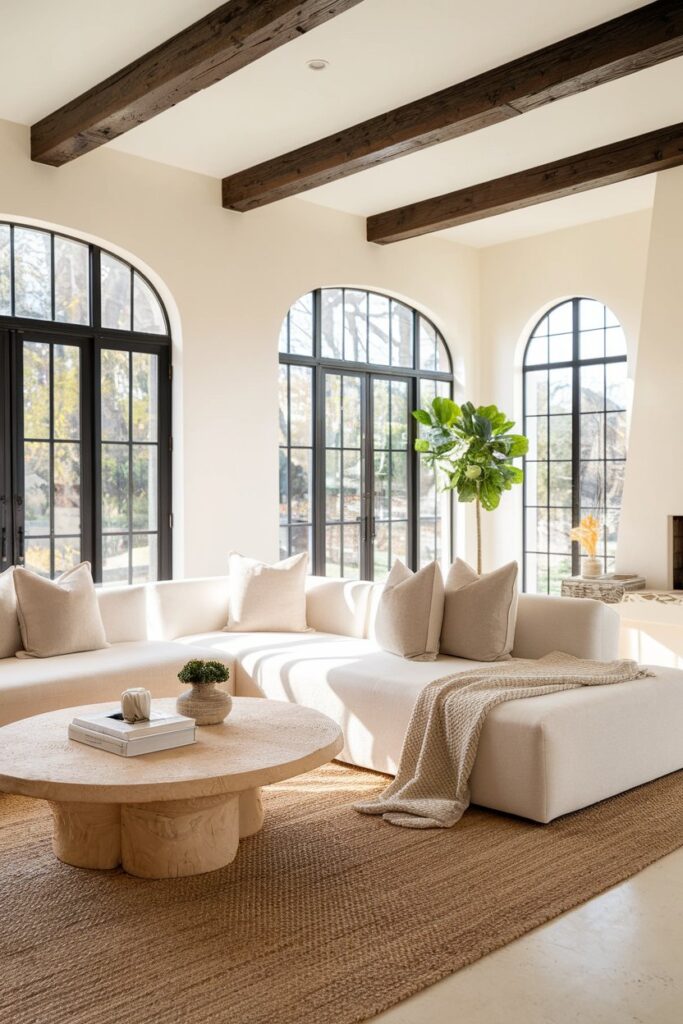
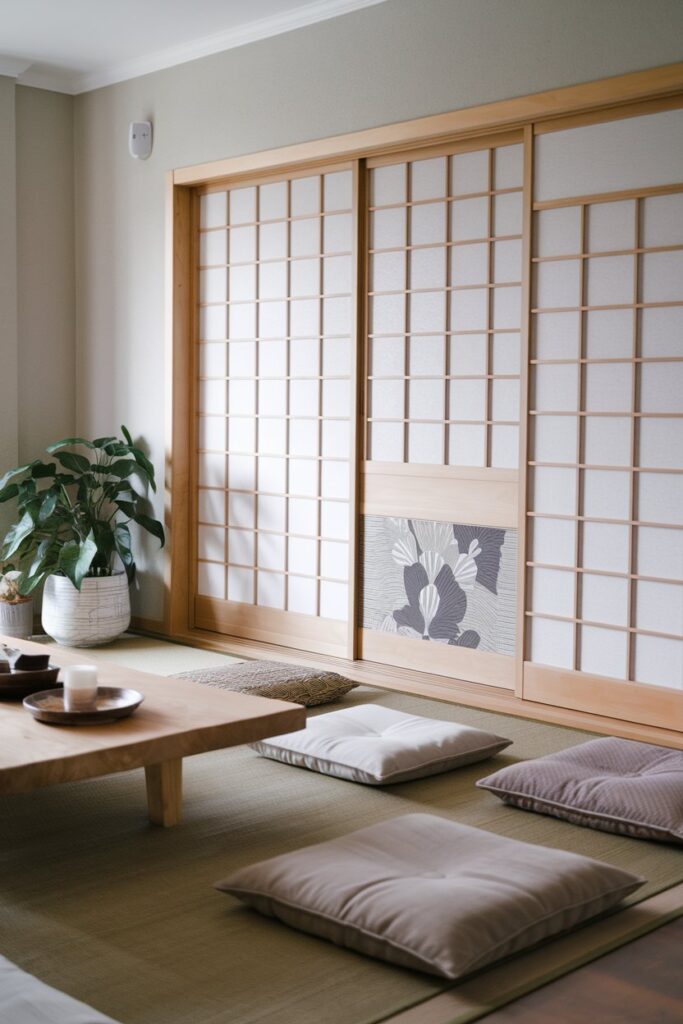

Wooden Elements and Their Implementation
Wood is key in Japandi design. It brings a natural beauty and warmth to any room. Choose wood tones like oak or maple to keep the Japandi look.
Textile Choices for Japandi Spaces
- Use linen fabrics for curtains, throw pillows, or upholstery for a soft feel.
- Add natural fibers like jute or bamboo for rugs, baskets, or wall hangings.
- Bring in organic cotton or hemp for a calm Japandi feel.
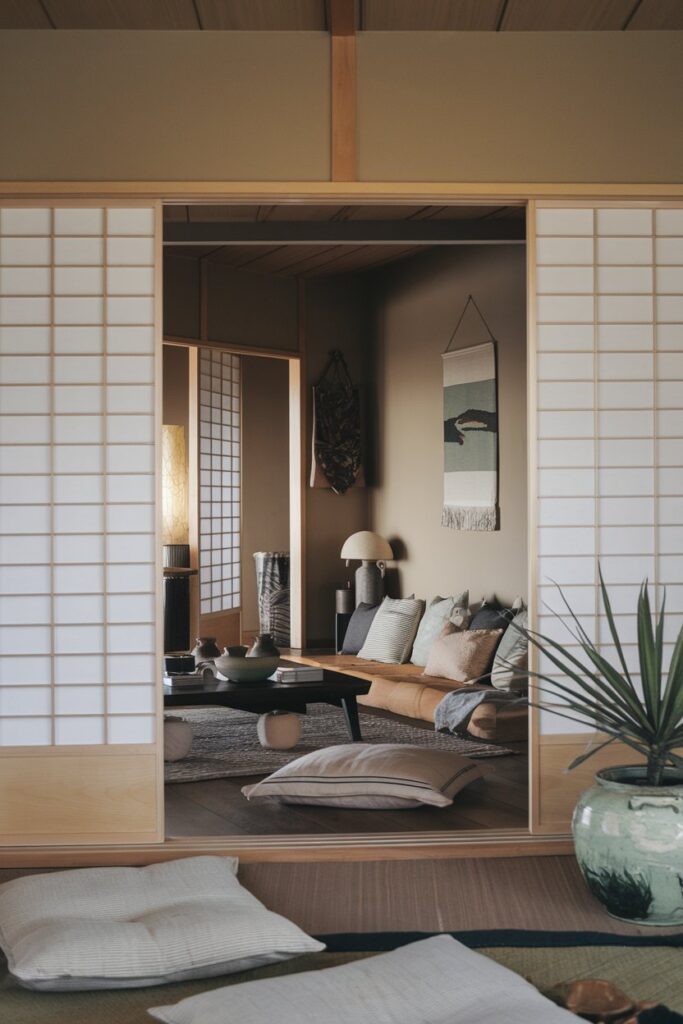
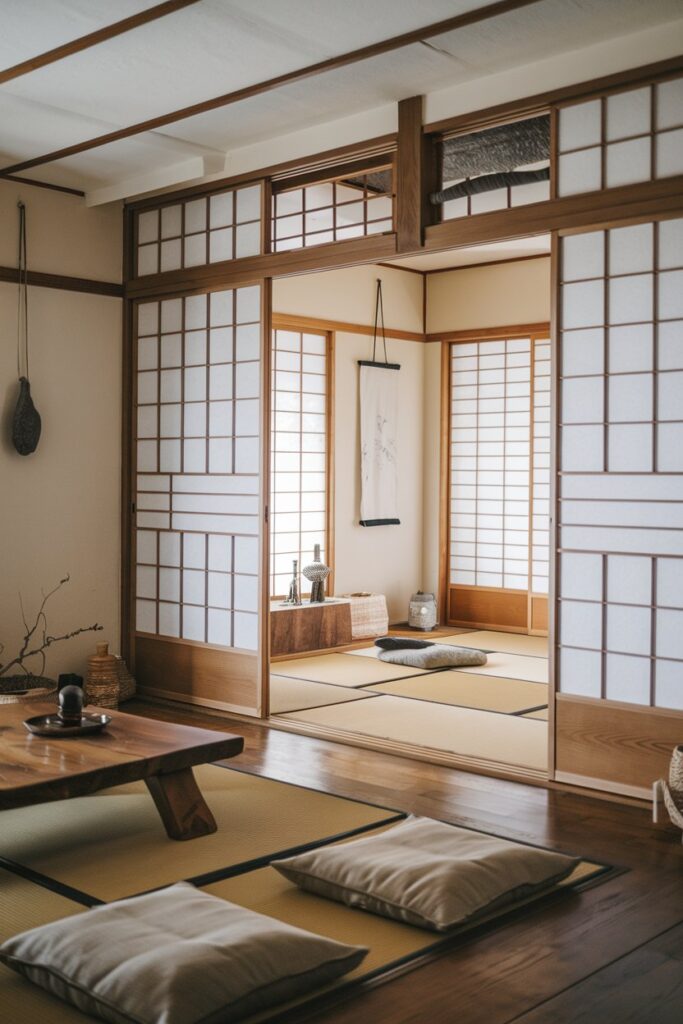
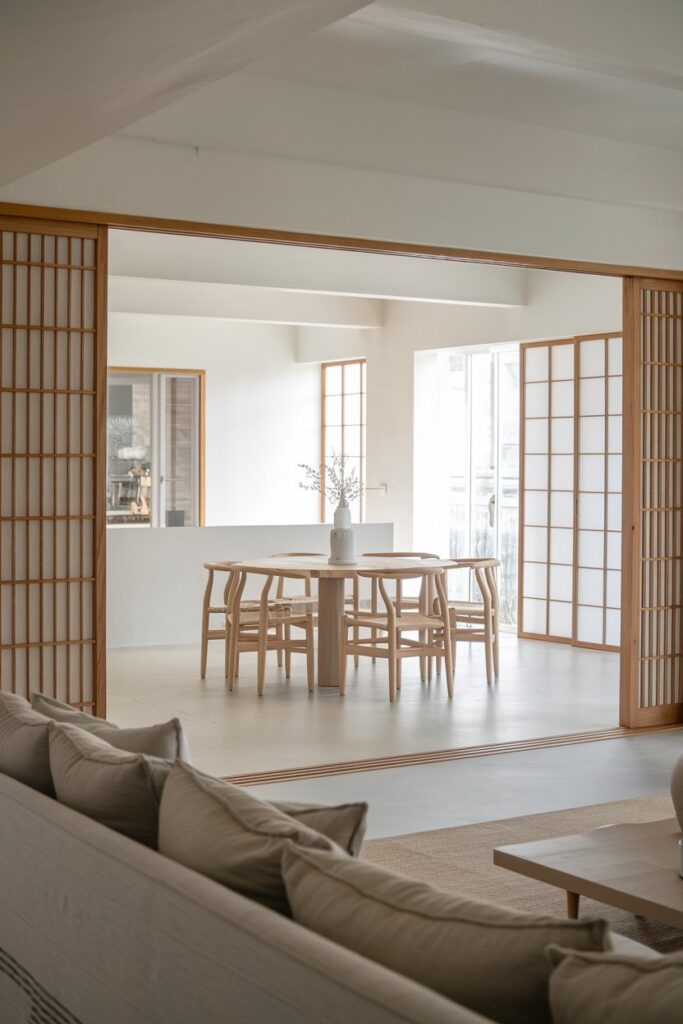
Stone and Ceramic Accents
Japandi design loves raw stone decor. Use natural stone for tables or fireplace surrounds. Pair it with ceramic pieces for a balanced look.
Choosing the right natural materials makes your Japandi living room warm and peaceful. It connects you to nature.
Minimalist Furniture Selection Tips
Choosing the right furniture is key in Japandi design. It helps create a calm, tidy living space. Look for furniture with clean lines and multi-purpose pieces to get the Japandi look.
Here are some tips for picking furniture for a minimalist Japandi living room:
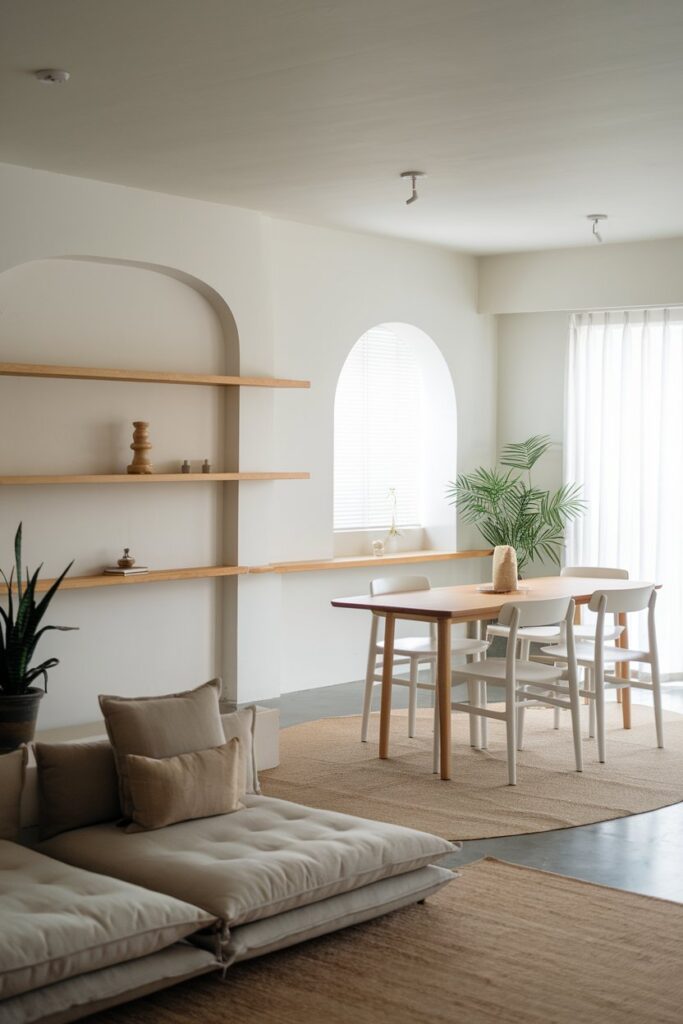
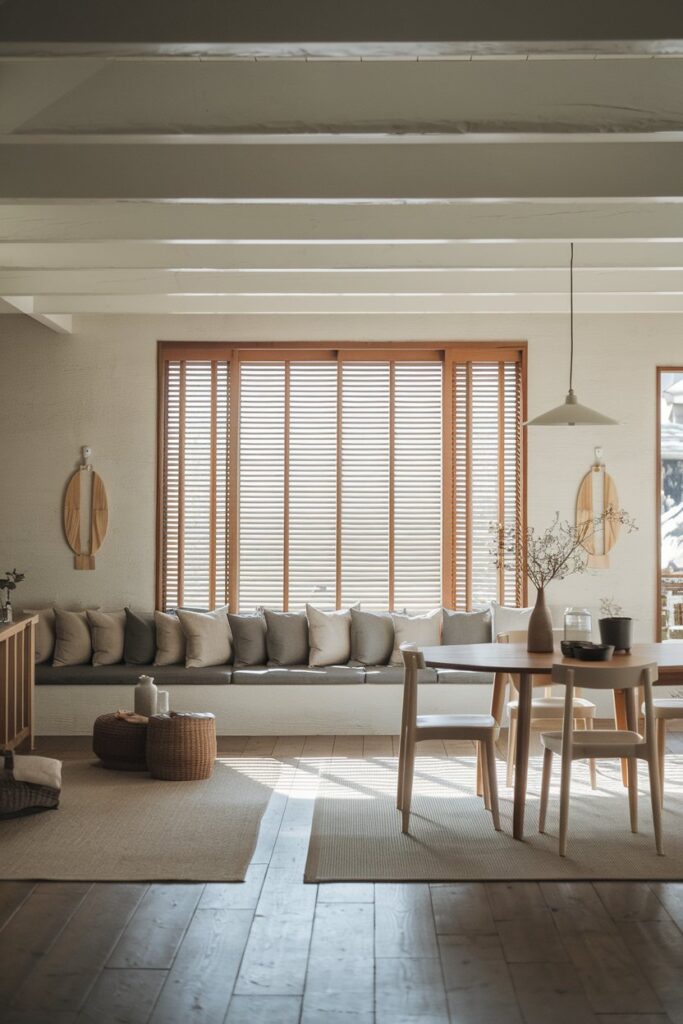
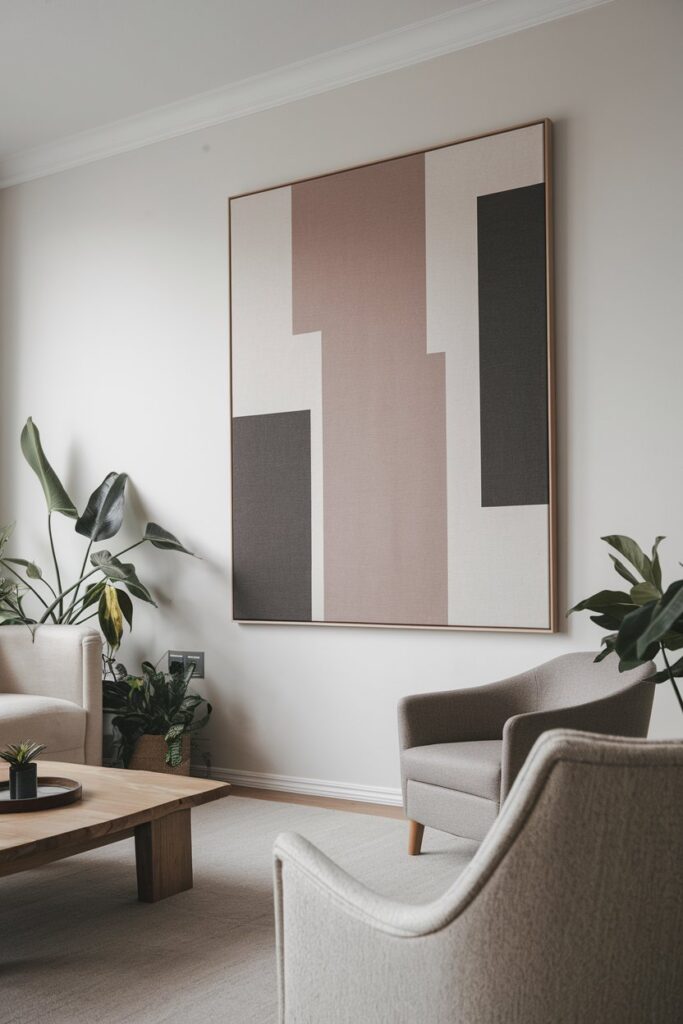
- Choose functional furniture that does more than one thing. For example, a coffee table with hidden storage or a sofa with shelves.
- Go for pieces with clean lines. They should be simple and not cluttered to keep the Japandi design looking good.
- Find multi-purpose furniture. This means furniture that can change its use, like a side table that doubles as a laptop stand.
- Opt for decluttered space furniture. This includes low-profile TV stands or minimalist bookshelves that reduce visual clutter.
Following these tips will help you create a Japandi-inspired living room. It will feel peaceful and balanced.
“In Japandi design, less is more. Every piece of furniture should serve a purpose and contribute to the overall sense of harmony in the space.”
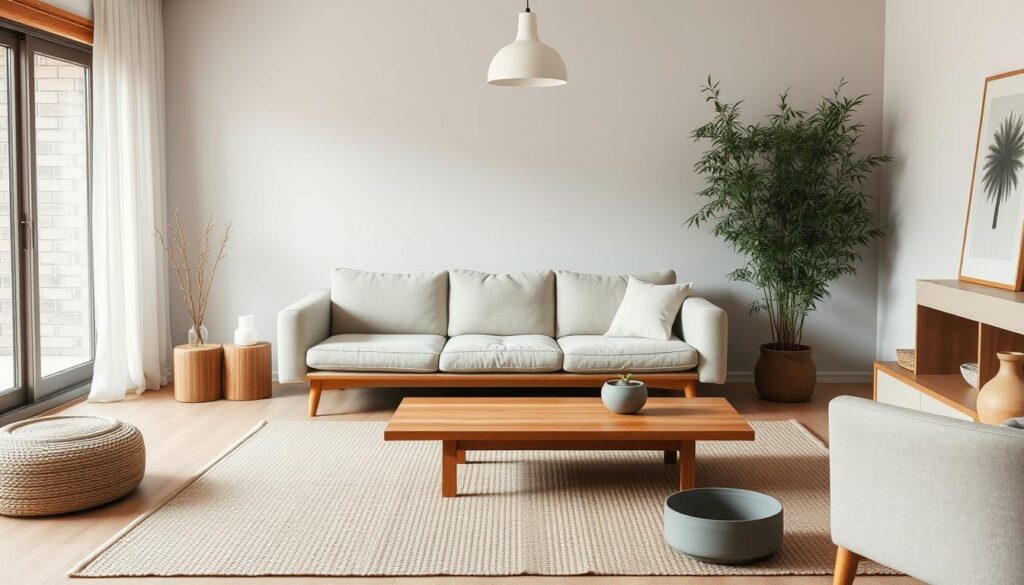
| Furniture Characteristic | Japandi Design Recommendation |
|---|---|
| Silhouette | Clean, minimalist lines |
| Functionality | Multi-purpose, with hidden storage |
| Material | Natural, such as wood and rattan |
| Color Palette | Earthy tones, with pops of neutral hues |
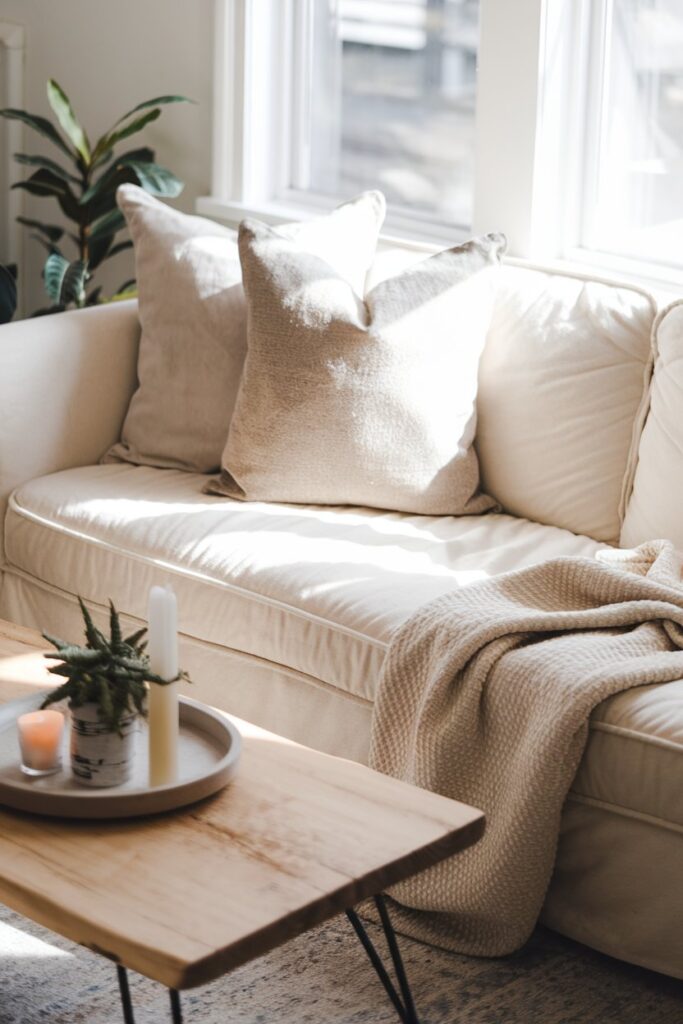
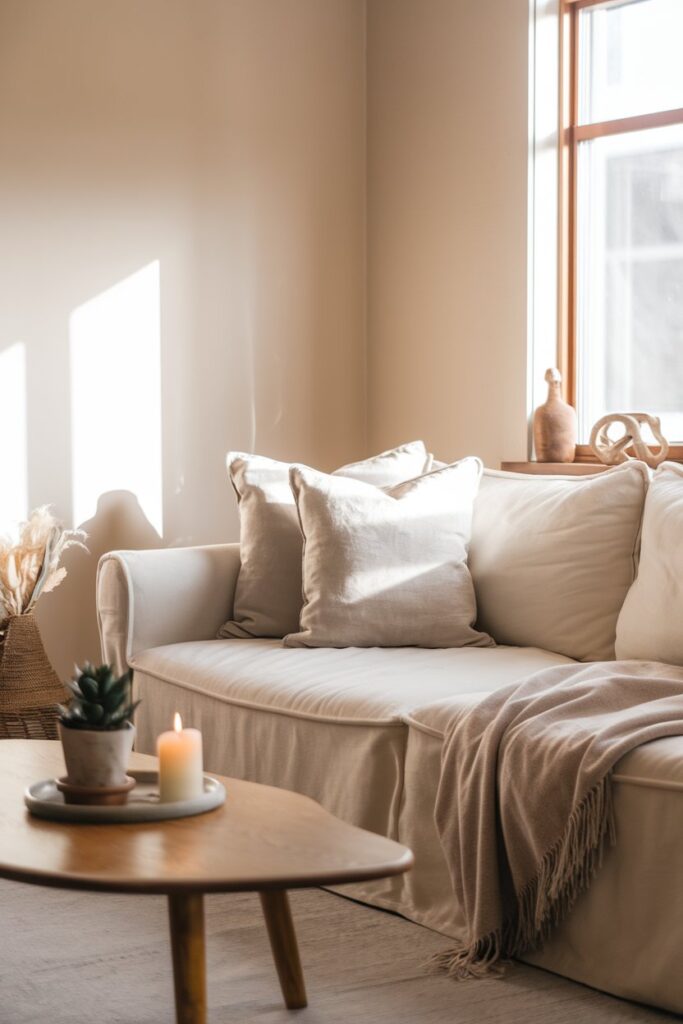
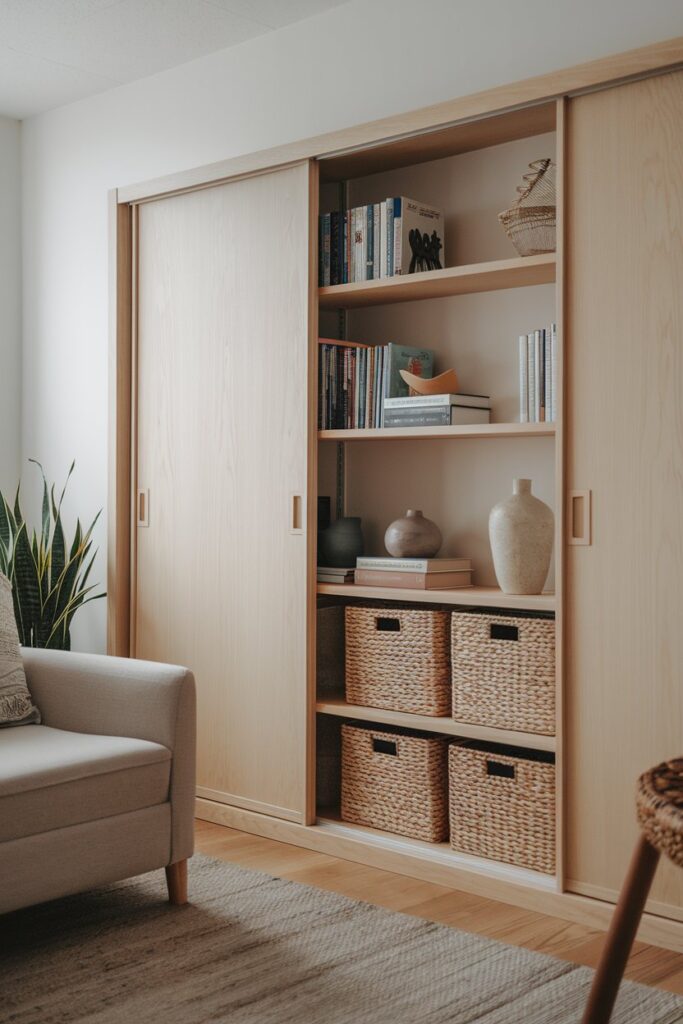
Japandi Living Room Ideas for Modern Homes
Japandi living room ideas mix Japanese and Scandinavian styles. They make modern homes look great. You can use open floor plans and negative space to create a simple yet functional space.
Layout Optimization Strategies
Design your Japandi living room to use space well. Choose open floor plans for easy movement. Place furniture to make different areas, like a seating zone or a reading spot, but keep it balanced for calm.
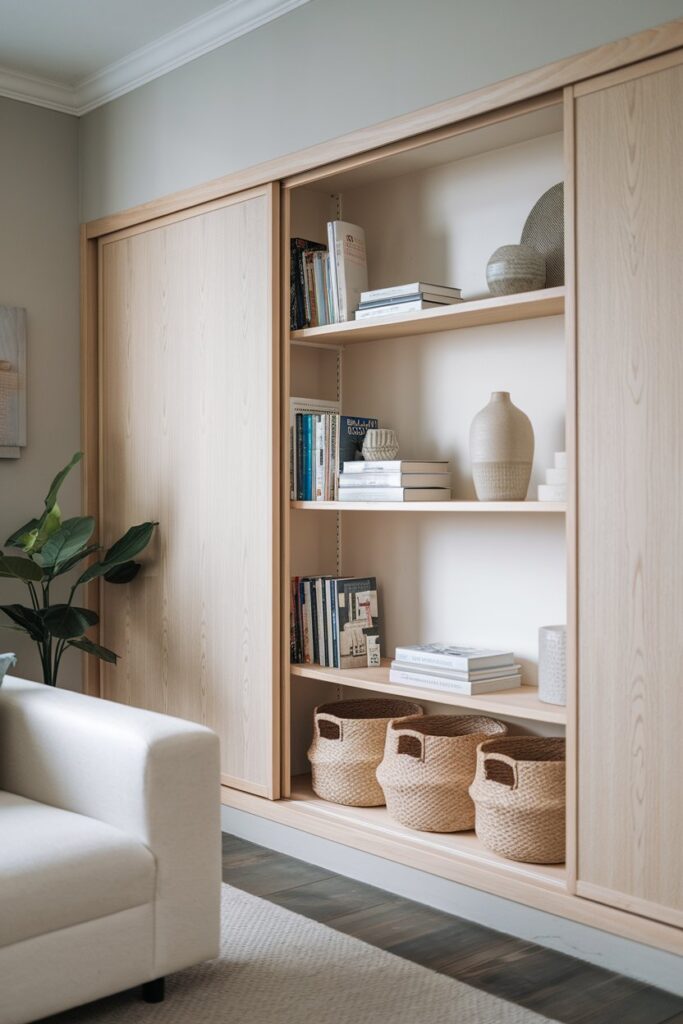
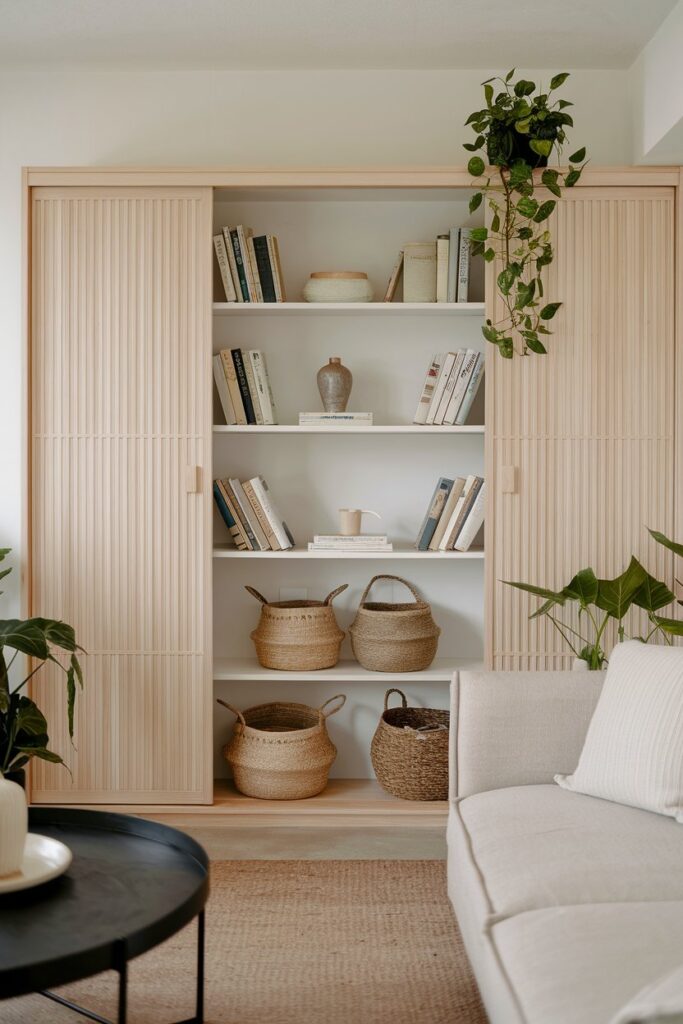
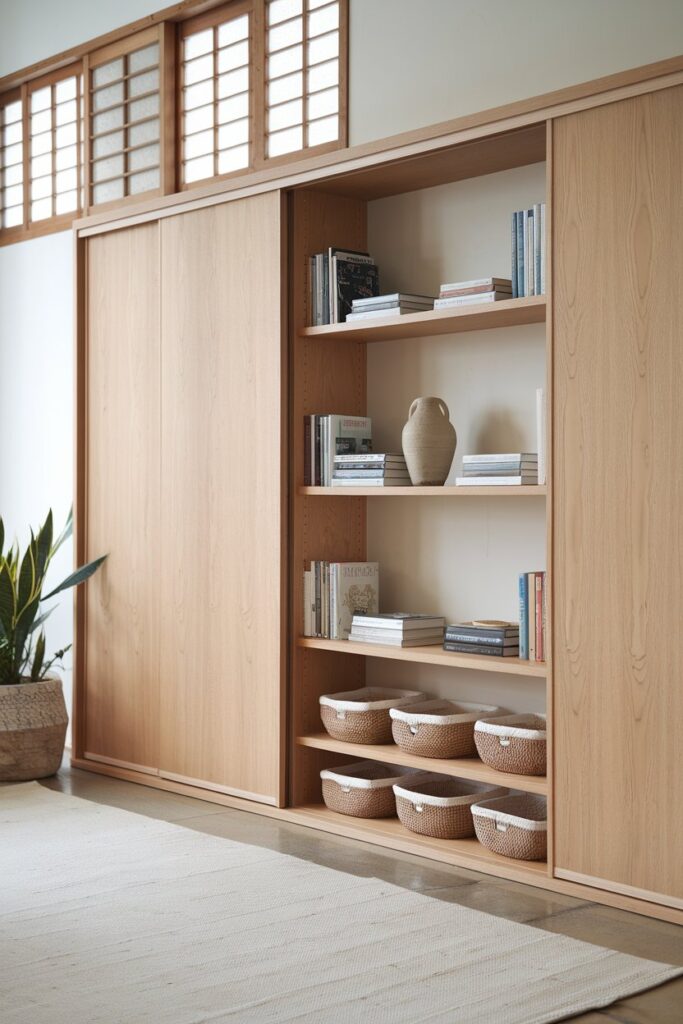
Focal Point Creation
Make a focal point in your Japandi living room. It could be a fireplace, a big window, or a simple art piece. Arrange furniture and decor around it to highlight it, keeping the area around it negative space.
Space Organization Techniques
Keeping your space organized is crucial for Japandi style. Use furniture that serves more than one purpose, like ottomans with storage. Add natural materials and textures to make the space feel cohesive and calm.
By using these Japandi living room ideas, you can make your modern home peaceful and balanced. It will blend Japanese and Scandinavian design beautifully.
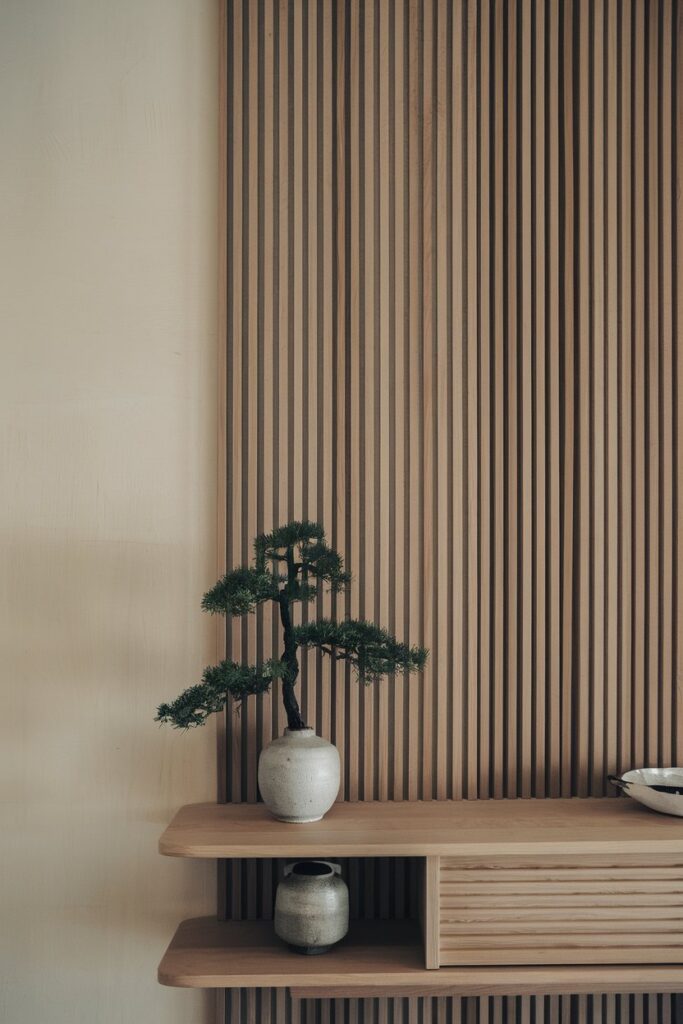
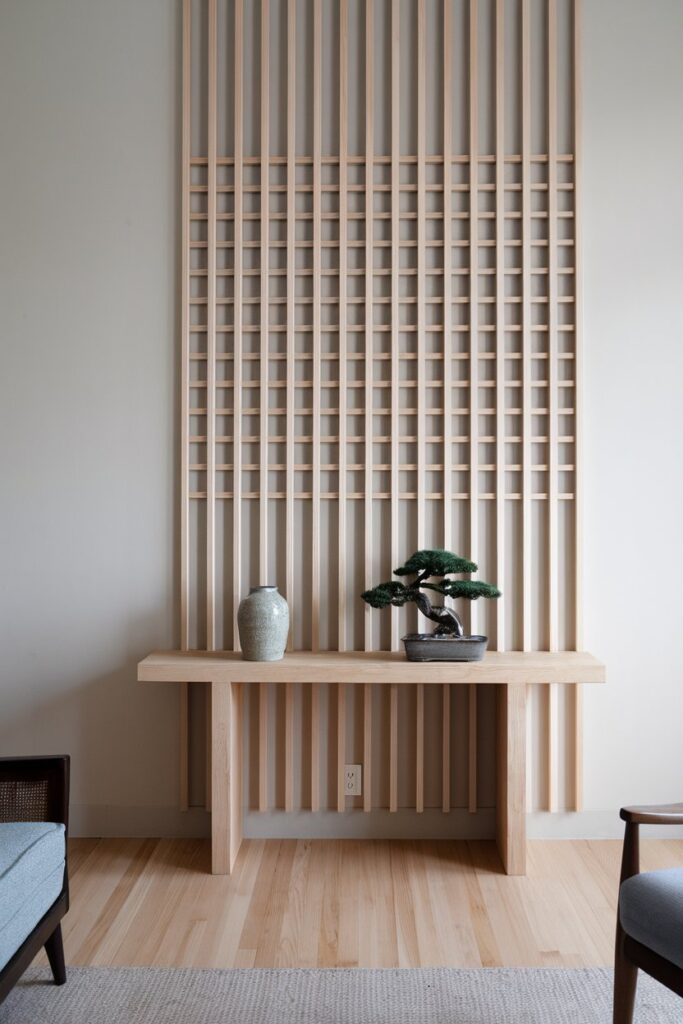
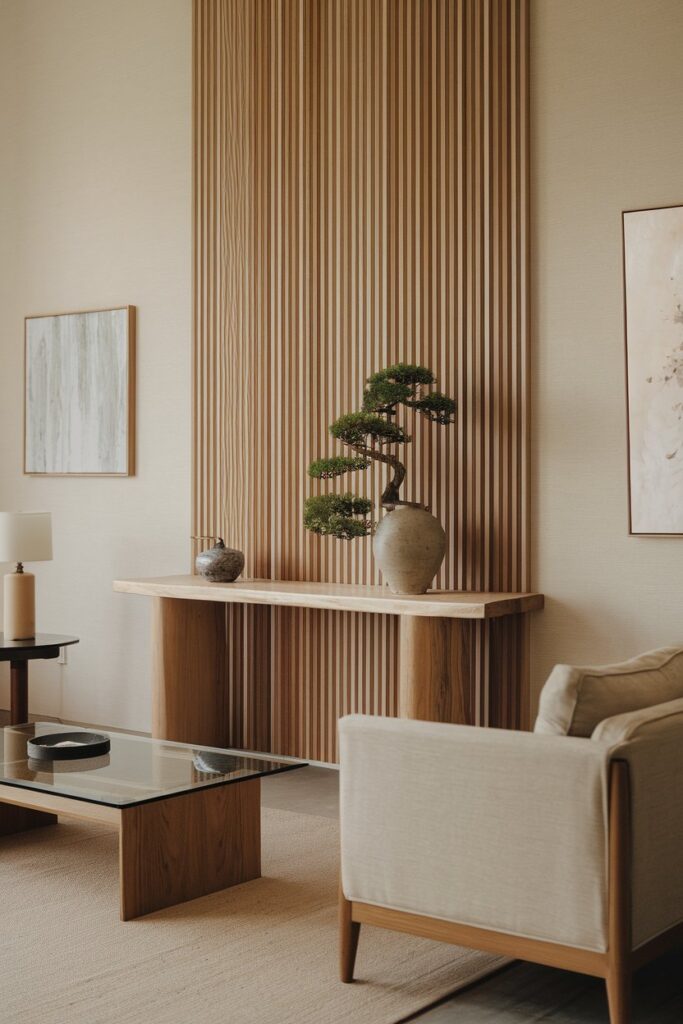
Lighting Solutions for Your Japandi Space
Natural light and soft, ambient lighting are key in a Japandi-inspired living room. Choosing the right lighting can make your space calm and minimalist. This is what Japandi design is all about.
Start by letting in as much natural light as you can. Large windows and sliding glass doors bring the outdoors in. Add paper lanterns or LED strips to shelves or windowsills. They create a gentle, warm light that works well with the natural light.
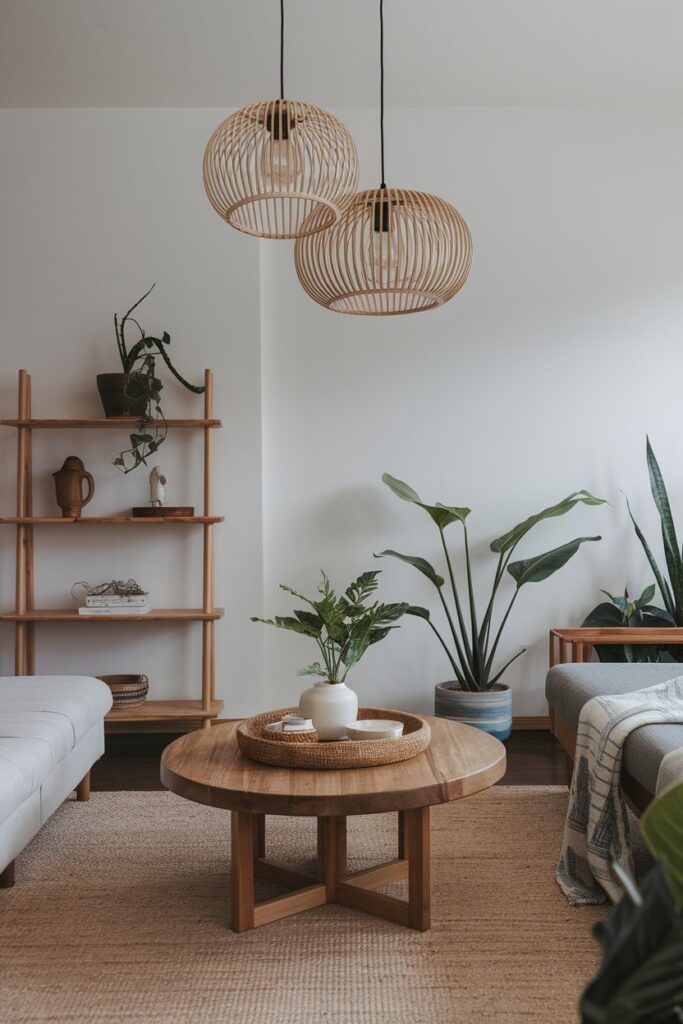
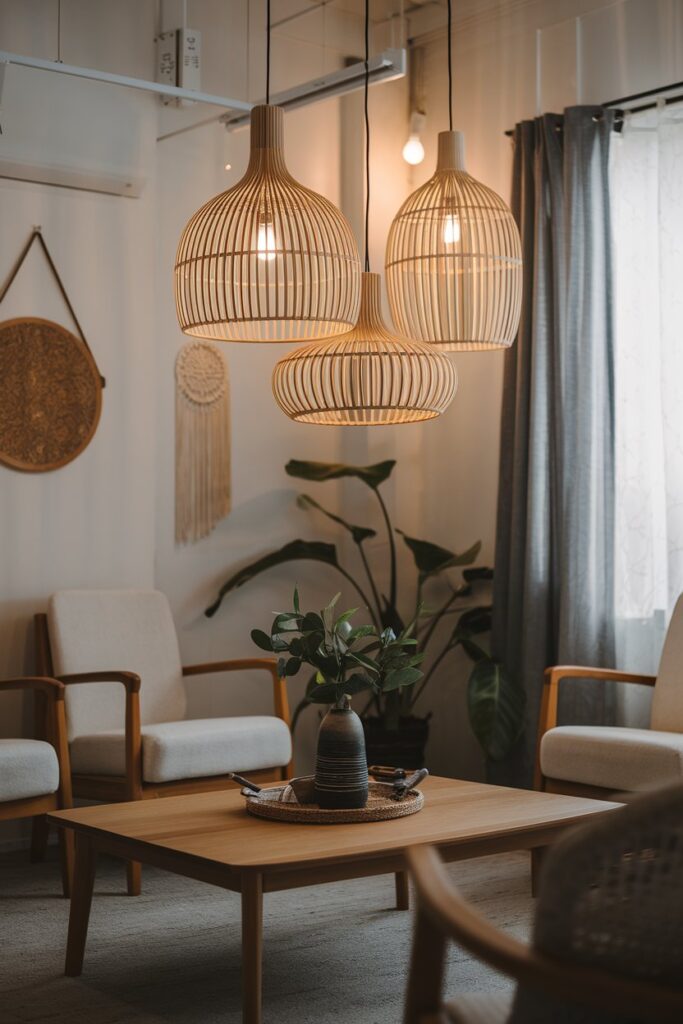
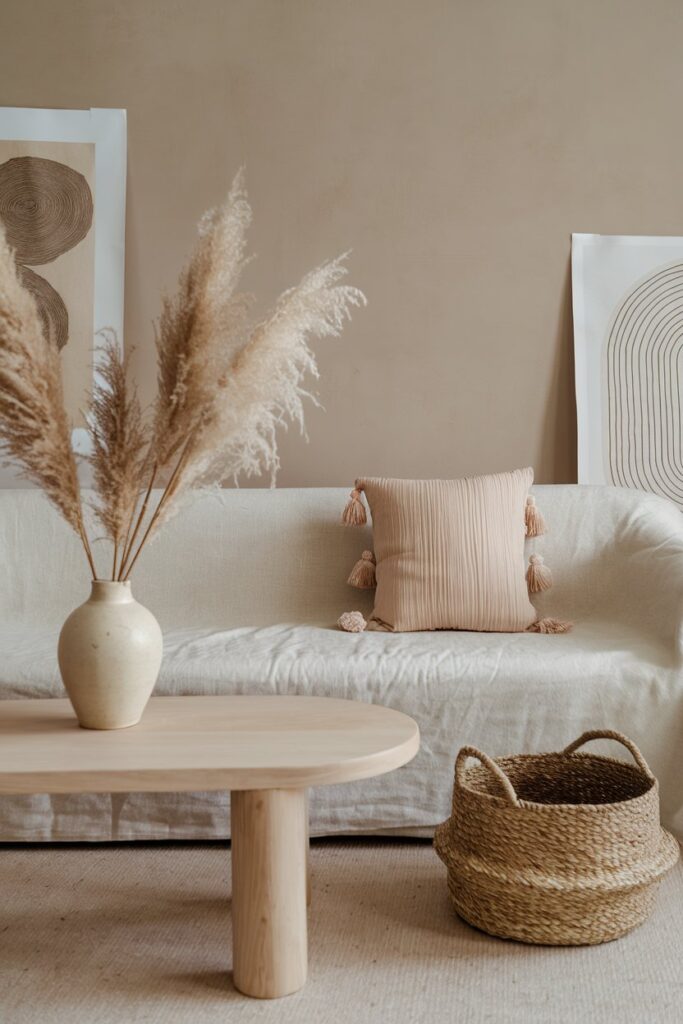
| Lighting Technique | Benefits |
|---|---|
| Floor lamps with paper lantern shades | Provide warm, indirect lighting that enhances the Japandi aesthetic |
| Recessed LED strip lighting | Adds subtle, ambient illumination without being the focal point |
| Pendant lights with natural light bulbs | Create a cozy, inviting atmosphere while maintaining a minimalist look |
The secret to great Japandi lighting is finding the right mix of natural light and ambient lighting. By combining these, you can make your living space peaceful and in line with Japandi design.
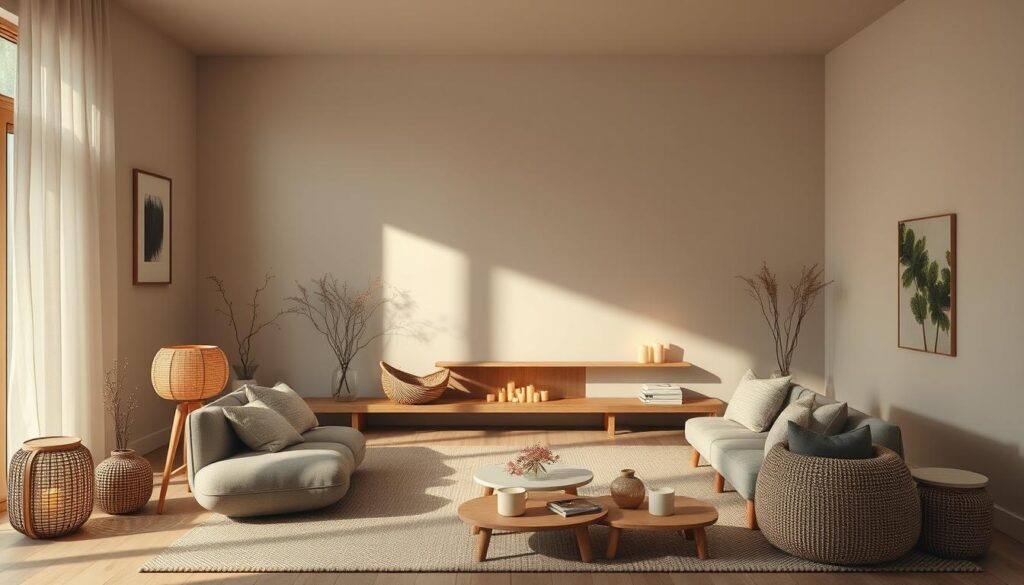
Incorporating Plants and Natural Elements
Japandi design connects indoor and outdoor spaces. It uses natural elements for a harmonious, biophilic living area. Plants and natural decor add warmth, texture, and a touch of the outdoors to your living room.
Best Plants for Japandi Aesthetics
For a Japandi-inspired living room, pick plants that match the clean lines and neutral colors. Some top picks include:
- Bonsai trees: These small, pruned plants capture Japandi’s essence with their detailed, natural shapes.
- Succulents: Easy-to-care-for succulents, like echeveria and jade plants, bring greenery with their unique, organic forms.
- Snake plants: Tall and architectural, snake plants (also known as mother-in-law’s tongue) do well in low light, perfect for Japandi rooms.
- Pothos: Pothos plants, with their trailing vines and heart-shaped leaves, add movement and natural beauty to the space.
Natural Decor Placement Tips
Adding natural decor to your Japandi living room is about finding the right balance. Place items like driftwood, river stones, or woven baskets to enhance the minimalist look without overdoing it. Try different setups and group similar materials or textures for a cohesive look.
The essence of Japandi design is in embracing natural materials. By choosing plants and natural decor thoughtfully, you can enhance your living room’s biophilic charm. This creates a peaceful, serene space that embodies the Japandi style.
Storage and Organization in Japandi Style
Embracing Japandi design in your living room means finding the right mix of looks and use. It combines Japanese minimalism with Scandinavian simplicity. Let’s see how to add hidden storage, built-in cabinets, minimalist shelves, and smart decluttering to make a peaceful, tidy Japandi space.
Japandi style loves clean, empty surfaces. Use hidden storage to keep your room tidy. Cabinets with hidden doors or drawers can store things without showing them. Add minimalist shelving for display space that’s also simple and sleek.
Decluttering is key to keeping the Japandi vibe. Sort through your stuff and get rid of what’s not useful or joyful. Use stylish baskets, boxes, and trays to keep small items organized, keeping your space clean and tidy.
“The true essence of Japandi design lies in finding the perfect balance between form and function. By thoughtfully incorporating hidden storage and minimalist organizational solutions, you can create a living room that is both visually stunning and practically efficient.”
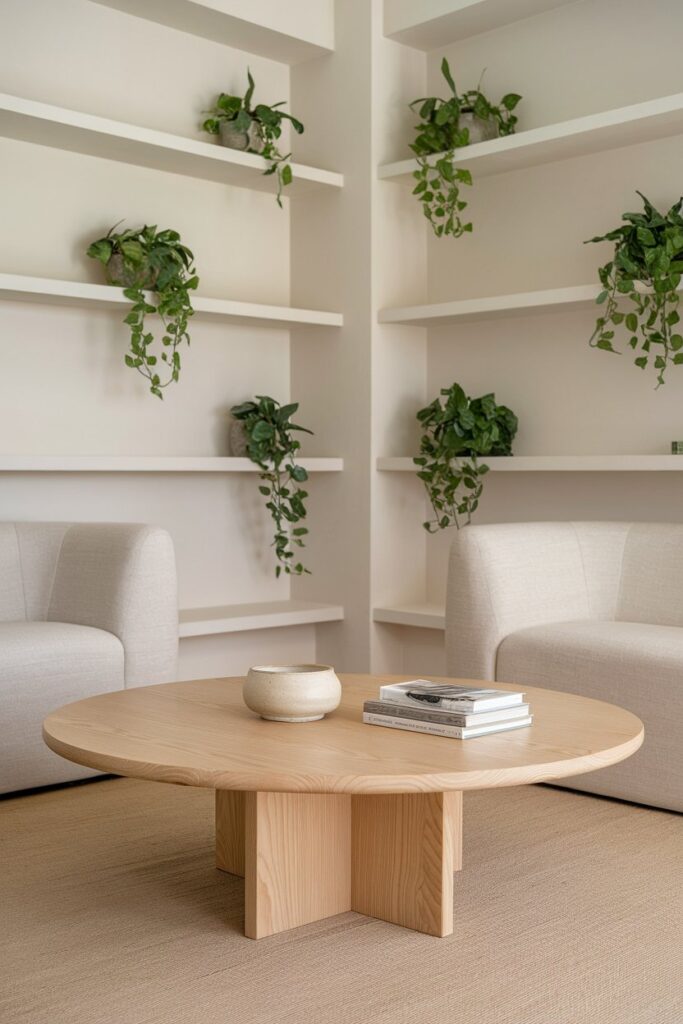
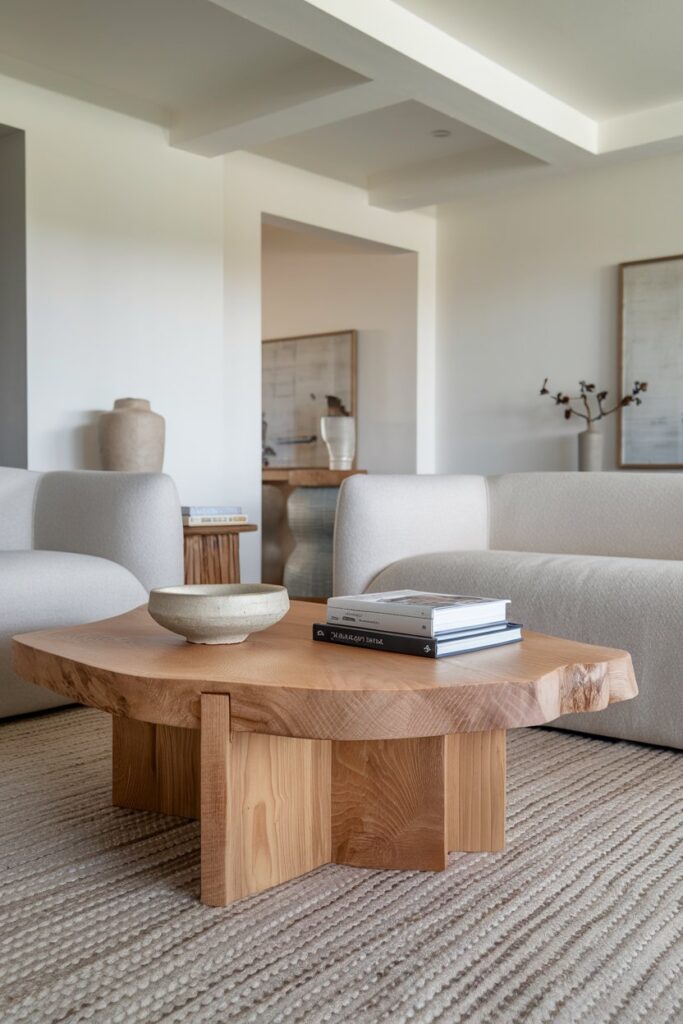
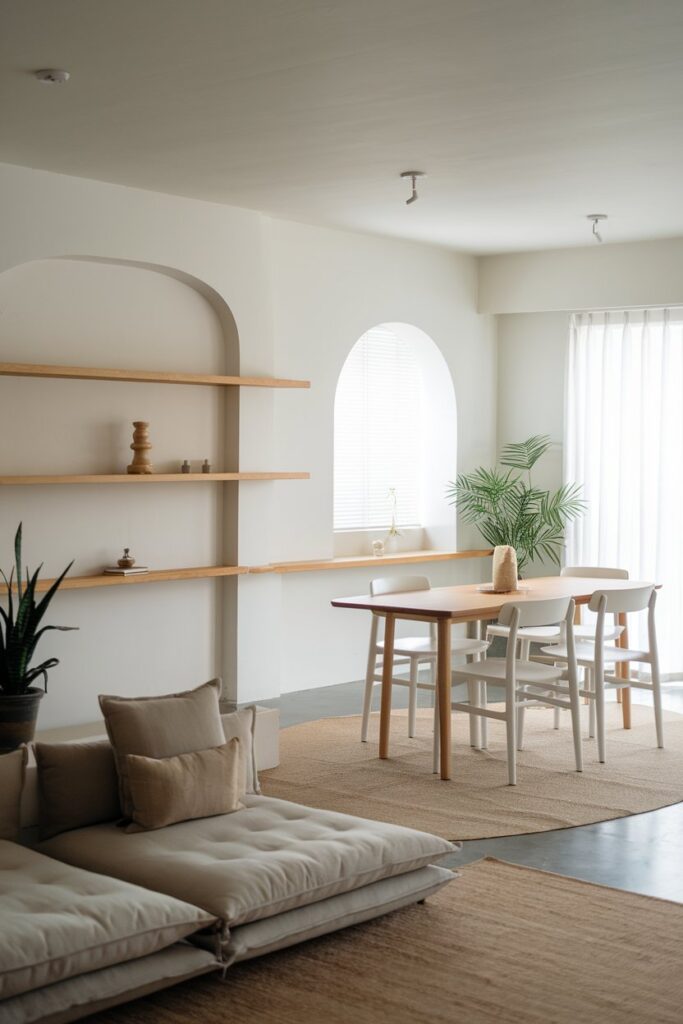
The secret to great Japandi storage and organization is simplicity, usefulness, and natural materials. By following these, you can turn your living room into a calm, tidy space that shows off Japandi style’s timeless charm.
Art and Wall Decor Selection
Creating the perfect Japandi living room is more than just furniture and decor. The art and wall hangings you pick can greatly affect the look. Choose minimalist art choices and focus on balance in composition for a calm, harmonious vibe.
Minimalist Art Choices
Go for abstract art and minimalist prints that fit the Japandi style. Look for pieces with simple lines, soft colors, and a Zen feel. These artworks will blend well with your Japandi room’s natural, simple look.
Balance and Composition Guidelines
When setting up your Zen-inspired wall decor, think about balance and arrangement. Group similar items or try asymmetrical setups that still look balanced. Play with different sizes and angles to find the best layout for your room.
By picking the right abstract art and minimalist prints, and arranging them well, you can bring Japandi design to life in your living room. Let your art and wall decor enhance the peaceful, nature-inspired feel of your space.
Creating Cozy Reading Nooks and Relaxation Areas
Turn your Japandi living room into a peaceful retreat. Create cozy reading nooks and relaxation spots. Use minimalism and natural elements to make these areas welcoming. Choose comfy seating like plush armchairs or built-in benches for a cozy feel.
Add soft textures with throw pillows, blankets, and rugs for extra comfort. Use task lighting like floor lamps or wall sconces for a warm glow. Add natural elements like plants or wood accents to bring Japandi design to life.
For a meditation or yoga spot, pick a quiet area and add a floor cushion or meditation pillow. Surround it with calming decor like a small altar or zen garden. This way, your Japandi living room becomes a peaceful place for mind, body, and spirit renewal.
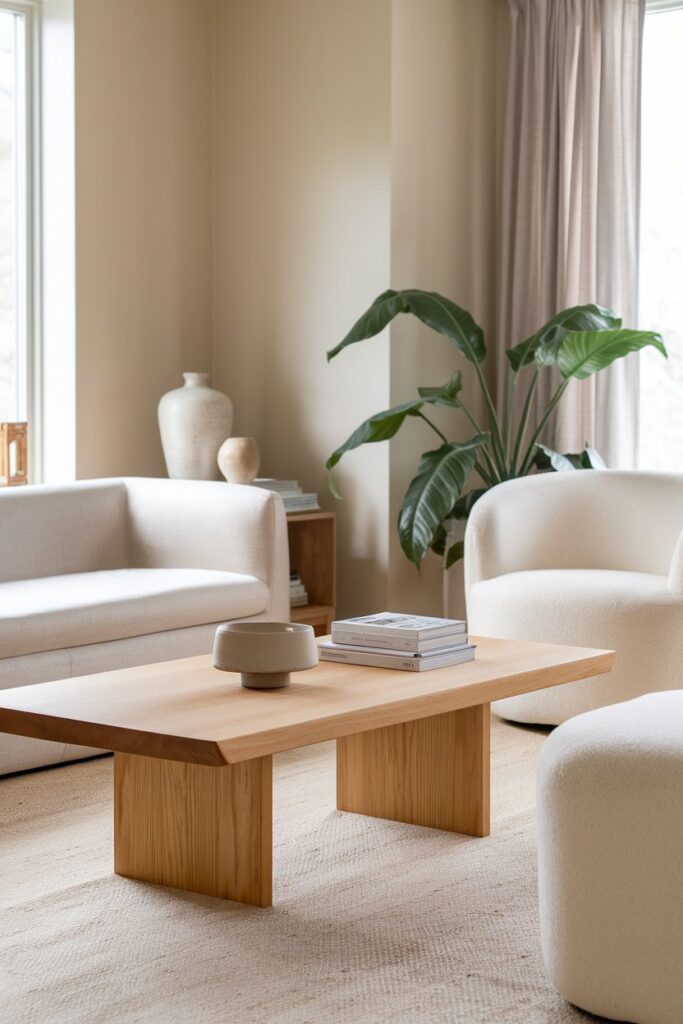
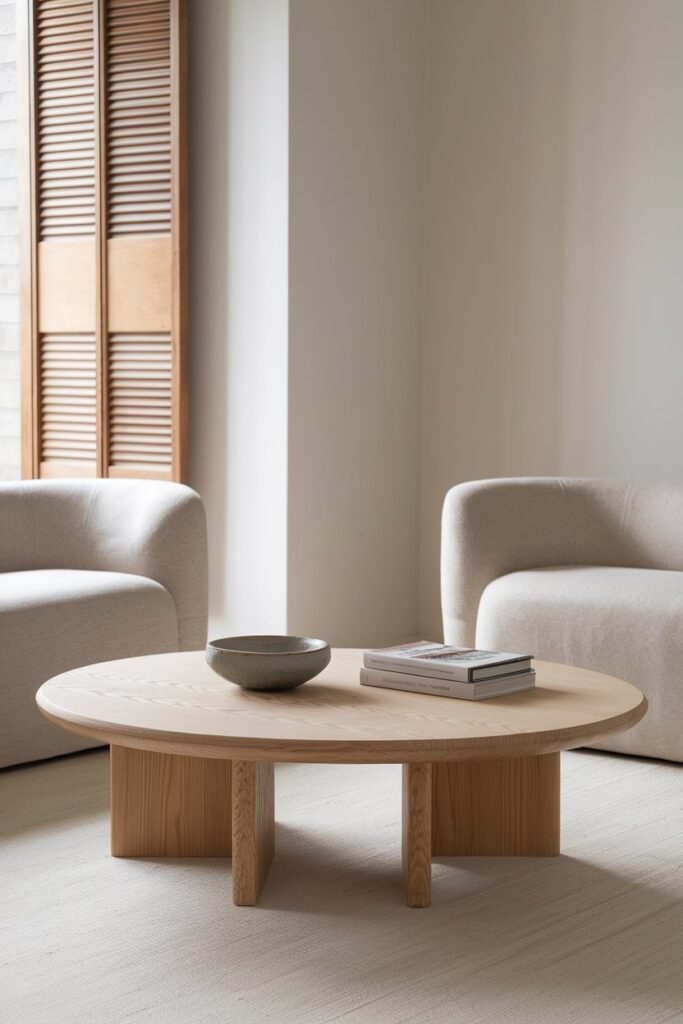
FAQ
What is Japandi design?
Japandi design mixes Japanese and Scandinavian styles. It combines minimalism, functionality, and natural elements. This creates a cozy and harmonious living space.
What are the core principles of Japandi style?
Japandi style focuses on wabi-sabi, finding beauty in imperfection. It also values hygge, creating a cozy atmosphere. Minimalism and natural materials are key, along with muted colors.
Why should I choose Japandi for my living room?
Japandi design makes your living room calm and serene. It emphasizes simplicity and functionality. Plus, it uses sustainable materials that are good for the environment.
What colors are typically used in a Japandi living room?
Japandi living rooms often use neutral and earthy tones. Think beige, gray, soft whites, and muted greens and blues. These colors create a calming atmosphere.
What types of natural materials are used in Japandi design?
Japandi design often includes wood, linen, stone, and ceramic. These materials are used in furniture, textiles, and decor. They add warmth and authenticity to the space.
How do I choose minimalist furniture for a Japandi living room?
Choose furniture with clean lines and simple forms. Focus on functionality. Opt for multi-purpose items and avoid clutter.
How can I optimize the layout of my Japandi living room?
Use open floor plans and arrange furniture for balance. Negative space helps create openness and tranquility.
What lighting solutions work best in a Japandi living room?
Japandi living rooms love natural light and soft lighting. Use paper lanterns, LED strips, and lamps for a warm atmosphere.
How can I incorporate plants and natural elements into my Japandi living room?
Add plants like bonsai trees and potted greenery. Natural decor pieces also enhance the space’s biophilic connection and authenticity.
What are some storage and organization tips for a Japandi living room?
Use hidden storage like built-in cabinets and minimalist shelving. This keeps the space clutter-free and visually appealing.
How do I choose and arrange art and wall decor for a Japandi living room?
Choose minimalist, abstract, or Zen-inspired art. Arrange it in a balanced way. This creates a calming and visually striking display.
